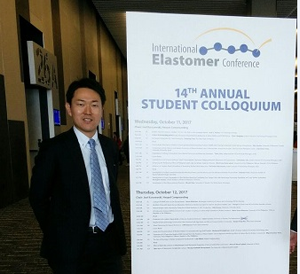Reinforcing mechanisms of silica / sulfide-silane vs. mercapto-silane filled tire tread compounds
Masaki Sato is a PhD student in the research group Elastomer Technology and Engineering (ETE). His supervisor is prof.dr. A. Blume from the faculty of Engineering Technology (ET).
 Although silica filled compound technologies have been global standard for passenger tire tread compounds nowadays, further performance improvements have always been demanded. To improve a dispersion level of higher surface area of silica, which is generally more difficult to disperse into the rubber matrix, seems to be one of the positive directions to increase the reinforcement level with decreasing the possible energy dissipation during a rotation of the tire. In the present thesis, by investigating the reaction mechanism of sulfide-silane and mercapto-silane the reinforcing structure which realizes a lower filler-filler interaction after vulcanization was clarified. Mainly two points seem to be the reason for enabling mercapto-silanes to achieve the lower filler-filler interaction. The first one is a higher shielding effect by a polymer attached to the silica surface, due to the higher addition reaction ability of mercapto-silanes to the double bond. The second point is the formation of a dense bound rubber structure by the radical propagation reaction between polymers started by the polymer carbon radical induced by the mercapto-silane radical. These structures suppress the silica flocculation during the vulcanization stage, resulting in the observed lower Payne effect values. However, as the effectiveness of mercapto-silanes on the above mentioned two points depends on the double bond structure of the polymer, mercapto-silanes are not applicable to all types of polymers. Furthermore, especially the second point can additionally explain the observed worse processability by the existence of the above mentioned dense polymer network already in the uncured compound. Further studies are still necessary to find the optimum way to balance the better silica dispersion level and the processability regardless of the polymer type. However, the findings presented in this thesis provide many crucial hints how to control during mixing the reactions which should occur and how to suppress the unwanted side reactions. The control could be done by the structure improvement of silanes and / or polymers or by third additives which have specific functions. The results in this thesis are expected to deliver a valuable contribution to find the optimum control which could lead to the next technical innovations in the tire industry.
Although silica filled compound technologies have been global standard for passenger tire tread compounds nowadays, further performance improvements have always been demanded. To improve a dispersion level of higher surface area of silica, which is generally more difficult to disperse into the rubber matrix, seems to be one of the positive directions to increase the reinforcement level with decreasing the possible energy dissipation during a rotation of the tire. In the present thesis, by investigating the reaction mechanism of sulfide-silane and mercapto-silane the reinforcing structure which realizes a lower filler-filler interaction after vulcanization was clarified. Mainly two points seem to be the reason for enabling mercapto-silanes to achieve the lower filler-filler interaction. The first one is a higher shielding effect by a polymer attached to the silica surface, due to the higher addition reaction ability of mercapto-silanes to the double bond. The second point is the formation of a dense bound rubber structure by the radical propagation reaction between polymers started by the polymer carbon radical induced by the mercapto-silane radical. These structures suppress the silica flocculation during the vulcanization stage, resulting in the observed lower Payne effect values. However, as the effectiveness of mercapto-silanes on the above mentioned two points depends on the double bond structure of the polymer, mercapto-silanes are not applicable to all types of polymers. Furthermore, especially the second point can additionally explain the observed worse processability by the existence of the above mentioned dense polymer network already in the uncured compound. Further studies are still necessary to find the optimum way to balance the better silica dispersion level and the processability regardless of the polymer type. However, the findings presented in this thesis provide many crucial hints how to control during mixing the reactions which should occur and how to suppress the unwanted side reactions. The control could be done by the structure improvement of silanes and / or polymers or by third additives which have specific functions. The results in this thesis are expected to deliver a valuable contribution to find the optimum control which could lead to the next technical innovations in the tire industry.





